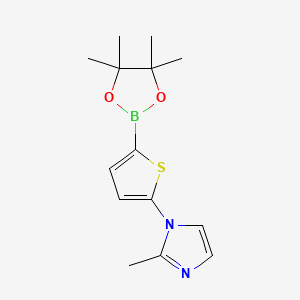|
Name: 4'-Methyl acetyl fentanyl (N-(1-(4methylphenethyl)piperidin-4-yl)-N-phenylacetamide)
Type: Synthetic opioid
AKA: N/A

|
|
II. Natural Derivative
Synthetic substance, no natural derivative
 |
|
III. Chemical Profile (IUPAC name)

|
|
IV. History
4'-Methyl-acetyl fentanyl, a synthetic opioid, was first synthesized in the 2010s. It is an acetyl fentanyl analog designed to increase potency and stability. The compound's introduction to the illicit drug market reflects ongoing trends in synthetic opioid development. Its potent effects and association with overdose deaths have led to heightened regulatory measures.

|
|
V. Legal Information
4'-Methyl Acetyl Fentanyl is a synthetic opioid with high abuse potential. It is regulated under opioid laws to prevent misuse and addiction, with global trends towards tighter controls. [Source: UNODC].
US Federal Schedule - I
Schedule I drugs, substances, or chemicals are defined as drugs with no currently accepted medical use and a high potential for abuse. Some examples of Schedule I drugs are: heroin, lysergic acid diethylamide (LSD), marijuana (cannabis), 3,4-methylenedioxymethamphetamine (ecstasy), methaqualone, and peyote.
Key US Federal Policies:
Controlled Substances Act. Public Law: Public Law 91-513 (text can be found on GovInfo) (https://www.dea.gov/drug-information/csa). Date enacted: October 27, 1970.
|
|
VI. Physical Effects
4'-Methyl-Acetyl Fentanyl, a potent synthetic opioid, emerged in the early 2010s. It acts as a downer, providing strong pain relief and sedation. Physical impacts include significant respiratory depression, decreased heart rate, and constricted pupils. Short-term use is effective for severe pain, but long-term use may lead to addiction, tolerance, and severe respiratory issues. Overdose risks include fatal respiratory depression. Safe use involves precise dosing under medical supervision. Recent research highlights its potency and risks associated with synthetic opioids.  |
|
VII. Psychological Effects
4'-Methyl acetyl fentanyl, an opioid, affects mu-opioid receptors, providing euphoria and analgesia. Immediate effects include mood elevation and sedation, lasting several hours. Long-term use may lead to addiction, cognitive impairments, and mood disturbances. Research focuses on its potency and associated risks of psychological dependence and cognitive effects.
 |
|
VIII. Culture
4'-Methyl acetyl fentanyl is a synthetic opioid, classifying it as a downer. Short-term use provides potent pain relief, while long-term use can lead to dependence, tolerance, and significant health risks. Overdose is highly dangerous, potentially leading to severe respiratory depression and death. Safe dosages are not well-defined, with use typically restricted to controlled medical settings. Recent research highlights its high potency and associated overdose risks. Physical effects include drowsiness, constricted pupils, and respiratory depression.
 |
